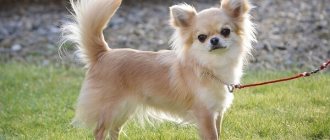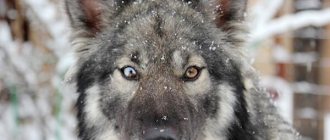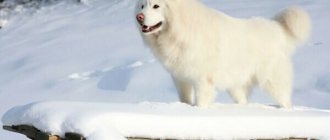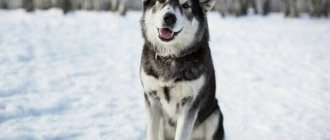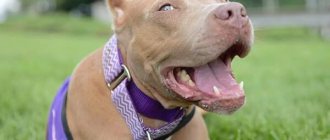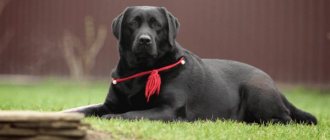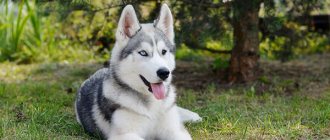Dogs such as malamutes and huskies are gaining increasing popularity both throughout the world and in Russia. Let's try to figure out how a husky differs from a malamute.
Alaskan Malamutes and Huskies were bred in northern latitudes and were used primarily as sled dogs. The birthplace of the former was Alaska, the latter - Siberia. They are very hardy, because in their native region temperatures drop below 30 degrees, and they often have to wade through deep snow in any weather. Both of these breeds, the Alaskan Malamute and the Siberian Husky, have proven themselves to be excellent companions in harsh environments. The dogs' personalities are very similar: they are energetic, playful, and get along well with people. Many people argue who is better - a husky or a malamute, but as a rule it is a matter of subjective preference. Natives from Alaska are distinguished by greater physical strength, and Siberian animals are distinguished by speed, but if we talk about modern conditions for keeping dogs, when they are rarely used for their intended purpose, these features lose their significance. However, let's figure out how to distinguish a husky from a malamute.
Huskies - huskies - malamutes
Laikas are the common name for many hunting dog breeds bred in the north of the European continent. Alaskan malamutes and huskies, strictly speaking, are not huskies; moreover, huskies significantly lose to them in sledding, but win in hunting. So if you intend to go hunting for a wild boar or a bear in winter, choose from the huskies, because Siberian sleds will catch small animals, and only for themselves - historically, in the summer, when there is no snow and the dog is sitting idle, it runs into the forest and fed on her own. They do not bring shot game to the owner. Eskimo dogs are also not strangers to hunting, but, again, more as entertainment or, if necessary, to search for food for themselves - their loved ones.
Sled dogs
The Alaskan Malamute, unlike the Husky, is designed to carry significant loads over long distances. At the same time, he develops a small speed, but stubbornly moves forward, no matter what. But huskies run briskly, their task is to quickly deliver a small load to its destination, so they often participate in speed competitions. Their movements are easier and freer. The Malamute, on the other hand, stands firmly on the ground, proudly raising its head and demonstrating a wide, well-developed chest, while even if huskies are cunning and curious in appearance, Malamutes are rather friendly. In addition, given their purpose, people from Alaska should be more calm; excessive temperament is considered a flaw here - perseverance and perseverance come first.
Appearance
In appearance, the difference between a husky and a malamute may not seem so obvious, this is one of the reasons why the two breeds are very often confused and even considered one, simply having two names. Siberians have a more elongated body, they are slightly smaller in height - literally by a few centimeters, and their tail is curled tightly. In addition, their coat is rougher to the touch and lies very smooth, but the undercoat is not as oily as that of their colleagues. The color of these dogs can be very different, but for malamutes the only monotonous color is allowed - white, all others - in a combination of white with black, gray or brown, and huskies can be both black and brown.
If you still can’t choose between two breeds, and you need a dog as a friend and not as an employee, then pay attention to a cross between a Malamute and a Husky. These puppies are offered quite often and have all the same great qualities of character and stamina as their parents, but are often more affordable, so they can be an excellent choice for those who are not looking for awards.
Just one look at a Malamute and stories about harsh northern regions, strong male friendships, hard work, and true love pop up in your head. He is like a revived trace of gold miners and desperate conquerors of new lands.
Plus, it looks infinitely close to the wild.
A kind of domestic wolf: noble, elegant and a little dangerous.
This sled dog breed is indigenous. their origin and name to the Eskimo Malemute tribe.
Malamutes have a rather long and difficult fate.
They have been endangered several times:
- during the gold rush, they were bred with other breeds to increase the speed of movement of the team;
- During the Second World War, the breed turned out to be unnecessary and its population rapidly decreased to a critical level.
Fortunately, the dangerous times are behind us: the Malamute is rightfully included in the TOP 100 most popular dogs on the planet, standing out noticeably among the conventional ones. In 2010, the breed was recognized as a symbol of Alaska.
Preferences
Who is better to take - a malamute or a husky?
When choosing between them, you need to remember that these are sled dogs. You will have to walk with them a lot and pay attention to physical activity. Huskies without energy return generally become real destroyers
Walking and playing together with a Malamute strengthens his respect for his owner.
An adult dog eats little - he needs about 500 g of meat per day, you can give cereals, fruits, and vegetables. But the Alaskan dog is very hungry for food. No matter what you eat, she will sit next to you and watch until she gets a piece. Siberians are more relaxed about treats and food.
We invite you to familiarize yourself with: Horse trailer for transporting livestock and large animals
Both breeds are not suitable for inexperienced dog owners. In order for dogs to obey you, you need to invest a lot of time and effort into their upbringing. Undesirable skills acquired through illiterate learning cannot be corrected.
Character, behavior
A dog with well-developed intelligence and enviable stubbornness. She is a leader by nature and needs a firm hand.
This breed is also called the “big teddy bear”. The Malamute is very friendly, playful, gets along well with children, and loves to be the center of attention. This is a pack dog that needs to live in a house. Living alone in a yard or enclosed enclosure will lead to the Malamute quickly becoming bored and withering away.
Physically and psychologically strong breed. Aggressive towards other dogs, stubborn, restless. Bad watchman. Protective service is also not for the Malamute. He is friendly to all people, and even rarely reacts negatively to strangers.
For the Alaskan Malamute, physical activity comes to the fore, because it is a northern working dog. She won't be able to live without them. He needs long walks and outdoor activities with a stick or ball. The owner should think about whether it is worth getting a dog that requires a lot of time.
People who live in the private sector should know that the Malamute is a digger. This is embedded in him on a subconscious level. For many years the dog had to get its food from underground. Therefore, your pet can easily dig up a vegetable garden or flower garden.
Interestingly, the dog loves to “talk” to people. The Malamute often makes muffled sounds and grumbles. He reacts to the sounds that a person makes and, as they say, maintains a conversation.
Malamute and husky differences
The Malamute is another northern sled dog breed.
Outwardly, they are very similar to huge wolves, but have a good-natured and affectionate character. Unlike graceful huskies, malamutes have a massive, heavy structure, thanks to which they are able to pull sleds with a large load. These dogs work well in a team, but have strong leadership qualities. If he recognizes his owner as a leader, he will faithfully serve him all his life. Compared to the lively nature of Huskies, Malamutes are calmer and more balanced. Another interesting character trait common to both Malamutes and Huskies is their dislike for cats. You shouldn’t try to make them friends with small dogs either. Confused with cats, harsh northerners may well kill them. Both breeds get along well with children, but if a husky sees a child as a partner for outdoor games, then malamutes behave with calm dignity, or even condescendingly. Both breeds are highly intelligent. But to succeed, the dog handler needs to interest and captivate the dog. In addition to excellent working qualities, huskies can make good guard dogs, while malamutes are absolutely non-aggressive and affectionate with all people. An important difference between Malamutes and other dogs is the absence of barking; they only sometimes “mutter.” This feature remained from their ancestors - wolves.
Laika and Husky: differences
Many people believe that huskies and huskies are the same thing. This idea is completely wrong. First of all, because the husky is a sled working breed, and the husky is a hunting breed. Laika is a northern representative of the Spitz class. From their famous ancestors, dogs received protruding ears and a fluffy tail, beautifully curved in a ring. Laikas have strongly expressed hunting qualities, and slightly less guard qualities. The dogs have a friendly and affectionate character.
To choose the right dog, you need to decide for what purpose it is needed. If you are choosing a dog for sporting competitions, then the best choice would be an Alaskan husky. Malamutes and huskies are ideal for harness work. But, more often than not, when choosing a dog, we choose a pet and a friend. In order for the years of life together to bring only joy, you need to be prepared for the manifestations of certain aspects of character inherent in a particular breed. For example, a husky feels better in a group of dogs. They have a lot of energy and if the dog has nowhere to spend it, the active mind begins to come up with activities that usually do not please the owner. Huskies need to be given a lot of time, walked a lot, and allowed to run without a leash. If a dog runs around in the yard, then the area should be surrounded by a high fence, dug deep into the ground. Out of boredom, huskies easily dig tunnels and break out for a walk. The undeniable advantage of these blue-eyed beauties is that their fur does not tangle and has no smell.
If there are no athletes in the family who can wear out active huskies, then it is better to choose a calmer Malamute. They get along well with people and children. The downside of this breed is that they are difficult to train. But once you communicate with a Malamute, it is impossible not to fall in love with this kind, grumbling wolf.
Among the huskies, you can choose a snow-white Samoyed, a very affectionate Yakut husky, or the largest representative of this species - the East Siberian husky. All types of huskies have good hunting qualities and are easily trained for a certain type of prey. With some likes, people also go after bears. You need to care for your husky's fur constantly and carefully. Be sure to comb it, especially during shedding. The fur of huskies is very pleasant to the touch and, like that of a husky, has no odor.
In the minds of ordinary people, the Siberian Husky breed is common to all sled dogs. You can often see advertisements for Alaskan Husky or Siberian Malamute puppies for sale, which can only make you smile.
Breeding sled dogs by inexperienced owners who don’t even know the correct name of their dog’s breed further confuses the situation. In fact, the Alaskan Malamute and the Siberian Husky are two different breeds that fall under the same general category of northern sled dogs.
Why were the breeds developed?
Huskies and Malamutes were bred as sled dogs for harness work. The main requirement is that the dogs overcome snow-covered roads in the endless taiga without any problems. The difference lies in the purpose of the breeds.
The Siberian Husky is a light and agile dog. He is able to run long and fast. But it cannot carry large loads.
The Alaskan Malamute is a heavy-duty breed. It is neither fast nor maneuverable. But he is very resilient and can easily move heavy things.
If we briefly describe the working qualities of dogs, then huskies are sprinters, and malamutes are marathon runners.
Breeds were bred on different continents. Husky appeared in Siberia and owes its origin to aboriginal dogs that served the Chukchi. The breed was registered in 1930.
The closest ancestors of the Malamute are wolves. This variety was developed by the Alaskan Eskimos, and since 2010 it has been the official state symbol of Alaska.
These factors determine the difference in size, appearance and character of the breeds.
Adding to the confusion is the Alaskan subspecies of the Siberian Husky. It is larger and more similar to a Malamute. This type is not recognized as a separate breed, but its representatives are popular and are actively bred.
Crossbreeds and mestizos
External resemblance does not indicate mating; such offspring are not desirable. The cross may be from other representatives, but as practice shows, they have the same health and behavior problems. We do not recommend taking dogs without documents.
There is a list of external features by which you can distinguish a husky puppy from a mixed breed:
- A husky puppy's ears are quite dense, erect, with slightly pointed tips.
- The tail is carried down and never rises above the line of the back.
- The bones are strong and strong, and should not be light, nor too massive and rough.
- The bite should already be correct at an early age, in the form of scissors.
- Little huskies have a lively, moderately inquisitive character, they are energetic and have nothing against communicating with people.
It should be remembered that only the puppy's mark and brand are guarantees of the purebred of the puppy, therefore, it is not recommended to buy a husky without documents.
This trait is often inherited by mixed-breed puppies, including those with unrelated breeds, even such as a German shepherd or pit bull.
We invite you to familiarize yourself with Husky in an apartment: how to turn a hurricane into a fluffy sleeping ball
Despite all the similarities in appearance and character, as well as in the historical purpose of the dog, these breeds are very different from each other. The Malamute was originally bred to transport heavy loads over long distances. And they do this even today, not too fast, but confidently, without a hint of fatigue, covering hundreds of kilometers.
Huskies have the endurance and tenacity of a Malamute, but due to their lighter weight, they are not able to carry very heavy loads. Their main trump card is speed. Alaskan dogs are well oriented in space, move fairly quickly and have a powerful build. This allows them to travel long distances without hindrance.
External signs
To people unfamiliar with dog breeds, they may seem almost identical. But still there are differences in them, and quite a lot:
- size (the Malamute has a powerful athletic build, it is more powerful and taller than the Husky);
- weight (malamutes are about 10 kg heavier than their relatives, commensurate with their height and volume, but huskies are prone to being overweight and obese, which cannot be said about their brothers from Alaska);
- wool (Siberian dogs, unlike larger Alaskan dogs, have a soft double coat; Alaskans have a coarse, long and hard coat);
- color (all malamutes have a characteristic mask on their face; unlike huskies, they are presented in a limited number of colors);
- eyes (like pieces of ice, bottomless, blue, it’s more about huskies; malamutes usually have wise brown eyes);
- tail (representatives of both breeds have a tail that is not too curled, slightly raised up; in Siberians it is more often curled into a crescent shape).
Other signs
In addition to external differences and similarities, dogs also have similar manners and behavior. Among the main characteristics are:
- hunter's instinct (representatives of both breeds survive well in the forest, hunting and getting their own food, but neither of them will bring their prey to humans, for them this is a method of survival, but not entertainment or work);
- riding qualities (both breeds belong to the category of northern sled dogs, which were created to run in a sled, the only difference is their heaviness, the malamute is sluggish, but carries large loads, and the husky is fast, but will not be able to take a large amount of things);
- character (the temperament of dogs varies radically, malamutes are calm, friendly and thorough, they will think several times before doing something, huskies are more temperamental, cunning and naturally curious, they do everything from a running start, thinking after).
Conditions of detention
Siberian dogs are so playful and active that they need daily exercise, long runs, and games in the fresh air. An apartment is not the best option for them. They need an enclosure that does not restrict freedom of movement and a balanced diet. Thick coat requires regular brushing. They are very clean and do not have an unpleasant odor. It is recommended to bathe them no more than once a year, and preferably less often. The coat of northern dogs is capable of self-cleaning.
Expert opinion
Anna Abramenko
An avid dog lover. Experience in veterinary medicine since 2009.
Ask a Question
Such dogs must be treated and given medications against worms and other parasites, and vaccinated according to the calendar.
The diet should include foods:
- meat;
- fish;
- dairy;
- eggs;
- fats;
- vegetables;
- fruits.
They can also be fed special foods that contain vitamins and minerals necessary for health.
Appearance
By the way, based on their appearance, people confuse not only huskies and malamutes, but also huskies and huskies. Moreover, huskies are not even a breed, unlike the Siberian husky, but rather a general name. And if huskies and malamutes are dogs for riding, then the husky is a hunting dog. There is also confusion between the Malamute and the Samoyed - these are both sled dogs. But without going into a detailed description, they are still easy to distinguish: the Samoyed dog can only be white.
The Husky is a medium-sized breed, in contrast to the Malamute with its large, athletic build.
At the same time, about the first one we can say that the dog’s movements are elegant (and energetic), and the malamute, as if realizing its size, moves more carefully. Dogs differ in texture
The Alaskan Malamute has a deep chest with very well-developed muscles. When a dog stands, it gives the impression of understanding its own dignity - its head seems to be proudly raised up. The Husky has a fast and light gait with relaxed movements.
Dimensions
Huskies and Malamutes have size differences that are not always noticeable to the uninformed person. But overall there is a definite difference. Huskies are smaller in size and weigh less. Dogs are more restless and mobile. The Alaskan Malamute is a mix of dog and white wolf. Therefore, its size is larger, it is characterized by a kind of clumsiness and massive paws. Heavy bones and pronounced muscles deprive them of speed. The size of an adult dog varies by gender and is 58–64 cm, and weight is 34–38 kg. Husky sizes range from 50–60 cm and 15–28 kg, respectively.
Coat and color
Probably the most noticeable difference in dogs is their color. The Malamute has one main color – grey-white. But the husky has a greater variety of colors.
Gray, gray and white, black and white, brown and white colors are allowed. The Malamute has a double coat - one layer is dense, the undercoat is similar to felt; the second layer is a stiffer wool for protection. The husky also has a double coat, but the undercoat is softer, and the protective coat always lies smoothly.
Head and eyes
The fact is that for a Malamute there is a strict standard - the eyes must only be brown. The appearance of a puppy with blue eyes is considered a flaw; dogs are not allowed to be bred, even if they are ideal in all other respects. But husky eyes are a kind of calling card; most photographs on the Internet focus on their blue, sky-colored eyes with eyeliner.
Yellow and brown colors are also acceptable. Multi-colored eyes are also considered standard; they are not considered a defect and have no consequences in a subsequent litter. The Malamute's head is wide and powerful, voluminous, proportional to the dog's body, prominent cheekbones with massive jaws. The husky's head is also proportional to the body, so it has a medium-sized, narrow, neat, “dry” muzzle.
Skeleton
The difference in the skeletal structure of dogs is also quite noticeable.
- massive bones;
- paws are large, thick pads (snowshoes), fur between the toes;
- knees have moderate angles, slightly bent, metatarsus straight down.
- medium bones;
- knees with pronounced angles, located close to the ground;
- The paws are medium-sized, oval, also with thick pads and fur between the toes.
Tail
The Malamute's tail is a swaying “fan” over its back, which does not curl into a ring. Can be pulled back during movement. The tail is more wolfish. The husky has a more fox-like tail - it is a round “broom” above the back. It can be directed upward during movement or bent like a crescent in certain stances.
Puppies
Externally, the puppies are similar in all respects, except for color - fluffy little balls with a perky character. It is difficult to recognize a mestizo among a group of kids. Therefore, you need to buy a pet only from an official nursery or club. The average cost of a Husky is 30-60 thousand rubles, and a Laika is 10-40 thousand rubles.
Photos of Laika puppies
Not every experienced dog breeder can raise Laika, because her character is more difficult to break. Therefore, before purchasing, you need to consider the option of purchasing both breeds and choose the appropriate one.
In all other respects (care, nutrition, training) the animals are similar. Both breeds require competent socialization and constant education. The owner needs to prove his leadership. Breeders really don't like it when dogs are confused. This also insults the feelings of the owners. Despite the opinion that Husky is a descendant of Laika, both species are included in the book of standards and are described by different criteria.
Differences between an Alaskan Malamute and a Husky
The difference between the breeds is significant - both in size and appearance, and in the nature of the breeds, which is due to the characteristics of the ancestors of these dogs. You can confuse them, but only when they are not standing next to each other. The breeds are often difficult to distinguish also because there is a subtype of the Siberian Husky called the “Alaskan.” These dogs are larger and more closely resemble Malamutes in appearance. But they have not been recognized as a separate breed, although they are actively bred and are popular among dog lovers.
Difference in character and behavior
Representatives of the breeds are similar in behavior. But there are some differences. Huskies are a good companion for games and walks; they are easy-going and intelligent, although independent, prone to pranks and disobedience. Representatives of another breed are calmer, but extremely independent and stubborn - they do not care about the desires and commands of the owner if something was missed during their upbringing. A Malamute, if this is the first dog, definitely needs lessons with a dog handler, since a beginner will not be able to train such a pet on his own.
The Siberian Husky is extremely “talkative”: the dog will constantly bark loudly, howl and make many other sounds. Malamutes are inherently silent; they rarely speak. But neither one nor the other breed has in its character anger directed at humans. This quality was specially removed - even during the birth of the breeds. At the same time, Malamutes are quite aggressive towards other dogs, especially towards their brothers in the breed. The struggle for dominance is in their blood, so between a pair of such dogs, most likely, there will be a fight almost immediately.
Dimensions
The Siberian Husky is noticeably more compact, the dog looks sleeker and lighter. The paws are thin, the pads are soft, they fit in the palm. For males, the normal weight is 20.5-28 kg, height at the withers is 53.5-60 cm. For females, the average weight is 15.5-23 kg, and height is 50.5-56 cm. Alaskan Malamutes have squat, paws they are powerful, the pads are wide and look rough. The normal height at the withers for males is 61-66 cm, for females - 56-61 cm. At the same time, males weigh 36-43 kg, and females - 32-38 kg. There is also a difference in fur parameters, head and tail sizes. For the Siberian Husky they are:
- the coat is not too long, not bristling, soft, color - from white to black;
- the head is medium-sized, narrow, “dry”, the ears are triangular, the tips are not smoothed;
- the iris can be of any shade;
- the tail is held vertically, in a stance - lowered downwards, it is fluffy, similar to a fox's.
Both breeds have almond-shaped, medium-sized eyes that are slightly slanted. Malamutes have the following characteristics of coat, head and tail:
- The head is voluminous and large, the cheekbones are massive, as are the jaws. The ears are triangular in shape, with slightly rounded tips.
- The iris must only be dark - heterochromic or blue is a disqualifying defect for this breed.
- The tail is covered with fluffy and long hair, dogs constantly wave it, while standing they can lay it on their back, but without pressing it or curling it into a “donut”. When moving, the Malamute's tail is held above the body.
- The coat is hard, noticeably bristling, from faded gray to black, from cream to brown. Coffee shades are acceptable, white bottom is required.
Standard
Direct purpose: working sled dog.
Dimensions: height 60-65 cm, weight 35-40 kg.
Body type
A strong, massive breed with a wide chest and well-developed torso. The back is straight, sloping down to the hips. Large muscular neck.
The legs are strong, muscular, “snowshoe” category. Joints with moderately pronounced angles. There is fur between the claws. The fingertips are hard and stable.
The tail is long, looks like a fan, and is lowered. The bones are large and coarse, proportional to the height of the dog. The depth of the chest is equal to half the height of the Malamute at the shoulders.
The Malamute's coat is medium length, hard, with a dense undercoat.
Head, muzzle
The skull is rounded, tapering towards the muzzle. Nose, lips, eyelids black. The lips fit tightly to the muzzle. The jaw is voluminous, with sharp large teeth. The eyes are medium, brown. Blues are a vice.
Head held high, proud posture. The ears are large, triangular in shape, and go up when the dog is alert.
Brief information about Husky
Photo and description
The dog is of medium height (approximately from 50 to 60 cm at the withers, weight is about 15-28 kg), compact, but at the same time harmonious build.
The body is slightly stretched and exceeds the height at the withers by no more than 2-3 cm; the shape of the head from above resembles a triangle, slightly tapering towards the muzzle. The stop is well defined, but not sharp.
The length of the muzzle is approximately equal to the length of the cranial part of the head.
The ears are erect, triangular, of medium size, set quite close to each other.
The eyes are almond-shaped, slightly slanted. Their color can be blue, brown, amber, olive. In addition, different eye colors are allowed.
IMPORTANT!
The nose, as well as the pigmentation of the lips and rims of the eyelids, depending on the color, can be black or brownish.
The neck is of medium length, the chest is deep and powerful, but not too voluminous. The forelimbs are moderately wide, even and parallel. The hind legs are muscular, with well-defined angulations of the hock joints. The tail is similar to a fox's, in a calm state it is lowered downwards, but when alert, it is carried in the form of a sickle over the back.
The coat is not too long, two-layered, while the undercoat is thick and soft, and the coarser hair is quite smooth and adjacent to the body. The color can be almost any, although the most typical colors for huskies are grey-white, black-and-white, brown-white and reddish-white.
Advantages and disadvantages
Pros:
- Intelligence and intelligence.
- Ability to make decisions independently when necessary.
- Lack of aggression towards humans.
- Love for children and playful disposition.
- Loyalty to the owner.
- Endurance and unpretentiousness.
- Easy hair care.
- They make excellent sled or sport dogs.
Minuses:
- Not suitable as guard dogs.
- Tendency to dig up the earth.
- Sometimes they are headstrong and stubborn.
- They often howl.
- They can be aggressive towards smaller animals.
- They need a lot of physical activity and long walks.
- Out of boredom, they can start to damage things in the house.
Character
Lively and friendly towards people. Huskies, unless serious mistakes were made during their upbringing, are never aggressive towards humans and are not inclined to bite.
Friendliness towards strangers and lack of territorial instinct make these dogs poor guards and this must be taken into account by people thinking about purchasing such a pet.
Huskies have an innate hunting instinct, but they will not make hunters either. These dogs hunt for game only for their own food and will never give it up to their owner of their own free will.
These are independent, independent, and sometimes stubborn and willful animals, prone to running away and wandering.
In addition, huskies love to dig up the ground and, out of boredom, can chew furniture, tear off wallpaper, or howl like wolves.
However, when keeping these dogs in the house, you need to take into account that most of the bad habits of a husky are easy to remove or simply prevent them from appearing in your pet. This is achieved through early socialization and proper education and training.
In addition, as noted above, huskies act out mainly from boredom and idleness, and therefore, if you provide the dog with sufficient mental and physical stress, it simply will not have time for mischief.
Features of training
When training an Alaskan Malamute, it is important to remember that this dog:
The breed is extremely stubborn. It is necessary to raise a puppy from an early age, and a person will need remarkable patience.
The best option for training is somewhere in a field in the fresh air. This dog loves space and games. Very inquisitive, during training he is often distracted by something extraneous.
The Alaskan Malamute easily follows the most complex commands, but only as long as he perceives them as a game. If he gets tired, you can't force him to do it. A Malamute cannot be put under pressure, threatened or punished. He, of course, will not respond with aggression, he simply will not perceive the person as a leader. The Malamute is difficult to wean. For example, if a dog is used to sleeping with its owner as a puppy or stealing treats from the table, it will continue to do this throughout its life. Therefore, the puppy also needs to be clearly explained what can and cannot be done. Any indulgences will lead to the dog simply becoming insolent.
This is a pack breed and needs a leader. If a person does not become one, the malamute will easily take his place and will command.
When training, it is important to remember that this dog loves to think. She needs tasks that simultaneously combine physical labor and nourishment for the brain.
A Malamute can easily take part in a bike ride, a hike, or help with housework (for example, carrying groceries from the store or digging up a plot). You just need to turn it into a fun game.
If a malamute does not see the point in a command, it will not carry it out. This dog has a rich history, solid experience in surviving in the most difficult weather conditions, and simple tasks are boring for her.
The Alaskan Malamute is a bad choice for a first dog. A novice dog breeder cannot cope with it. By the way, this breed is considered one of the most abandoned. People fall in love with the “big teddy bear,” but when the dog gets older, they just can’t handle it.
Appearance
If you put representatives of both breeds side by side, it will not be difficult to distinguish individuals of one variety from the other. External differences between Malamute and Husky include:
- size;
- tail;
- wool quality;
- color;
- head shape;
- facial expression;
- eyes.
Dimensions
The Husky is noticeably smaller in size than the Malamute. This dog has a natural sprinter's build, as well as some traits that are typical of a hound. It is characterized by:
- mobility;
- good reaction;
- grace;
- flexibility.
Unlike the Siberian Husky, the Alaskan Malamute has a large skeleton, which makes it overweight. Such a dog gives the impression of a rough tractor. She is squat. Its paws are short, powerful, with wide, rough pads at the ends.
Comparative parameters of the dimensions of dogs of both breeds are given in the table below.
| Breed / Parameters (height at withers (height) and weight) | Males | Females |
| Husky |
|
|
| Malamutes |
|
|
As can be seen from the table, huskies are noticeably inferior to malamutes in height and even more so in weight, which in the latter can be twice as large.
https://youtube.com/watch?v=OooxSllc_y0
Tail and its features
The Siberian's tail is similar in appearance to that of a fox - just as voluminous and fluffy. Contrary to popular belief, a husky's tail is not curled. This shape is typical for the husky. The husky has a maximum possible tail curl - crescent-shaped. Usually they hold it vertically (always in this position when moving), but they can also tilt it slightly towards the back. When taking a stance, the “Siberians” lower their tail down.
In Malamutes, this limb resembles a fan. This is due to the fact that its coat is longer and fluffier than that of a husky. When standing, Alaskans simply place their tail on their back, and when moving, they keep it slightly raised above their back.
Coat and color
If you compare the quality of the coat, then the husky’s is much better. Their hairs:
- have an average length;
- are distinguished by softness;
- don't puff up.
In terms of color, Siberians come in any color - from white to black.
As for Malamutes, their coat is hard. The hairs stick out in different directions. In terms of possible color options, these dogs are in no way inferior to huskies. Their fur comes in the following colors:
- from light gray to black;
- from light beige to rich brown;
- red;
- coffee.
White underparts are required for purebred Malamutes. That is, the fur on the paws, belly and chest, regardless of the color of the fur on the back, these dogs are always white.
Based on their color, Malamutes are divided into two within-breed categories - Kotzebue and M'Lut. The latter includes individuals of the wolf color. Kotzebue Malamutes come in a variety of colors. It is worth noting that dogs of these breeds have similar colors. But this does not make them so similar to each other that they can be confused.
Head, eyes and muzzle
Compared to Malamutes, Huskies have thin, “withered” features. The muzzle of the Siberian dog is narrow and of medium size. The Alaskan's head, on the contrary, has a three-dimensional shape. Malamutes have massive jaws and cheekbones.
The ears of both breeds are triangular and erect (most of the time). They are very similar among representatives of the species, but still not the same - the ears of “Alaskans” are more rounded, while those of Huskies are noticeably sharper.
Dogs' eyes are also quite similar. In dogs of both one and another breed they:
- medium size;
- almond-shaped;
- they mow a little;
- partly with an asymmetrical arrangement.
As a distinctive feature, eye color is much more important than their shape and other features. Malamutes are only allowed dark irises. The blue-eyed "Alaskan" is considered defective. A husky can have any eye color. And individuals with a blue iris, as well as those with heterochromia, are held in special esteem. Dogs with such external characteristics are the most in demand, the demand for them never subsides.
By their look and facial expression, Malamutes seem much kinder than Huskies. This impression is due to the color, which is characteristic of “Siberians”. It is he who gives their face a grumpy and at the same time cunningly mischievous expression. In addition, the husky's gaze seems angry and constantly wary. It is worth emphasizing that such an impression is deceptive. By their nature, huskies do not correspond to him.
The Malamute's muzzle and its expression turn this dog into a good-natured glutton. The dog's facial expressions are pleasant and funny. A kind, playful expression never leaves his face, his gaze is direct and open. The appearance of the Malamute is more than attractive. And this external good nature is by no means deceptive.
Hypothermia
Even covering plants with fabric or film will not save them from the cold when growing in open ground. Therefore, observe the timing of planting seeds specifically for your region, plant in greenhouses and hothouses, and use early-ripening varieties.
Signs
If the tomatoes still managed to suffer from the influence of low temperatures, this will be noticeable by the following signs:
- growth slowdown;
- widespread yellowing of leaves;
- border that has become bluish;
- redness of the stem in some cases.
You can try to save the fruits by spraying with adaptogens like aloe or zircon - just one drop per liter of water is enough.
How to care
A very demanding dog to care for and maintain. She has long and thick hair, and on hot days the Malamute needs water treatments. They at least somehow help her freshen up. The breed does not tolerate high temperatures above zero.
You need to bathe your Malamute with a special product and rinse the fur thoroughly. Afterwards it needs to be dried well and combed. Hairballs can lead to the development of diseases. The Malamute sheds twice a year: in spring and autumn. During shedding, the dog will have to be brushed every day. If this is not done, mats will form that will fly around the house or yard in huge clumps.
Malamutes need to rub their eyes with clean water once a week. Clean your ears once a month. Cut your nails once every month and a half.
What to feed
The Malamute eats less than other breeds of the same size. They are partial to tasty food, which is what they should take advantage of during training. But an unlimited diet often leads to volvulus, so you need to feed your Malamute carefully.
A dog vitally needs fish and meat. It is better to limit the consumption of cereals, as well as dry food. This breed loves everything natural. During World War II, she had to eat rodents and small animals, so she has a special love for meat.
The pet eats great fresh fruits and berries, and is partial to nuts.
A one-month-old puppy needs to be fed three times a day. Portions are small. The diet should contain:
- Milk porridge;
- Raw meat, cut into pieces;
- Boiled eggs.
When your pet turns 2 months old, the diet should be varied. You can give him:
- Boiled zucchini, potatoes, raw tomatoes and carrots;
- Fresh fruits and berries (apples, apricots, cherries and currants);
- Fish, preferably sea fish.
How long do they live?
Malamute lives 12-15 years. You can significantly extend the lifespan of a Malamute if you care for it properly and regularly. In this case, the dog will not have health problems. She is physically hardy and feels great in the cold. Rarely gets colds.
The breed is most susceptible to the following diseases:
- Volvulus;
- Eczema;
- Hip dysplasia.
To minimize the development of these and other ailments, the dog should not be overfed; it needs to be combed out, periodically bathed and subjected to physical work.




